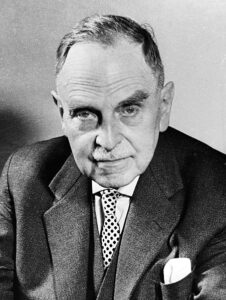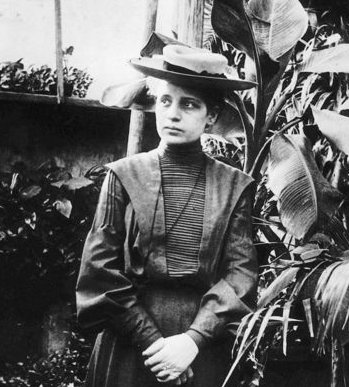Lise Meitner has an element, Otto Hahn a Nobel Prize. This is evidence of the esteem in which the science community holds both scientists. They worked together for over thirty years, were born a year apart and died fifty years ago. While their lives are closely entwined their collaboration is not without controversy.
Early lives

Lise Meitner was born in Vienna in 1878. Her father, a Jewish lawyer expected her to train as a French teacher. This she did, so it was 1901 before she entered university to study what she wanted – physics. In 1905 she became only the second woman at the University of Vienna to obtain a Ph.D. The supervisor of her research on the conduction of heat was the famous physicist, Ludwig Boltzmann. In 1907 she moved to the University of Berlin to work with the discoverer of the quantum theory, Max Planck. There she met Otto Hahn.
Hahn was brought up in the German city of Frankfurt. Like Meitner, he did not follow the career, architecture, that his businessman father wanted for him. He chose chemistry and obtained his doctorate in organic chemistry in 1901 from the University of Marburg. He moved to London to learn English, expecting to enter the lucrative organic chemical industry. While working with William Ramsay, the discoverer of the noble gases, he was given the task of extracting radium, recently discovered by Marie Curie, from a radioactive mixture. He discovered a new, highly radioactive, form of the element thorium. He went to Canada in 1905 to spend a year learning more about radioactivity and radiochemistry from Ernest Rutherford. Then he returned to Germany to take up a post at the University of Berlin working in Emil Fischer’s radiochemistry department.
Collaboration
The authorities at Berlin, particularly Fischer, did not approve of women scientists. Meitner was not allowed to even enter a laboratory. Nevertheless, she and Hahn began to work together. Meitner found space in a disused carpentry workshop. Hahn was interested in discovering and isolating new radioactive substances – new elements and new isotopes of known elements. Meitner worked on the properties of the radiation the samples gave out. Their work progressed and in 1912 both became members of the prestigious Kaiser Wilhelm Institute in Berlin. In 1913 Hahn married Edith, a Pole who he had met at a conference.

The outbreak of the First World War in 1914 disturbed their research. Hahn was called up by the army and Meitner worked as a nurse. They still managed to do some work together and in 1917 announced their first major discovery – the new element, protactinium (atomic number 91). After the war, they continued working together with Meitner now head of the department of radiation physics. Hahn was appointed Director of the Institute in 1928 and held the position till 1944.
Modern alchemy
Following Rutherford’s discovery of the proton in 1919 (wait to next year for more on that) Hahn and Meitner, like many other scientists became interested in nuclear reactions both natural and artificial. These reactions were a transmutation of one element into another. This was what the ancient alchemists had tried to do. They had failed and Dalton’s Atomic Theory said it was impossible. The nuclear chemical reactions studied in the 1920s and 30s produced elements that were one or two places to the right or left of the starting element in the Periodic Table. The discovery of the neutron by Chadwick provided another particle to aim at the atomic nucleus. Italian physicist, Enrico Fermi, wondered if it would be possible to turn uranium, the heaviest naturally occurring element, into new elements with atomic numbers greater than 92.
In 1935, Hahn, Meitner and a younger scientist, Fritz Strassman, developed Fermi’s work firing neutrons at samples of uranium. At first, they got confusing results which suggested that they might have made transuranic elements or radium, four places before uranium in the Periodic Table.
Exile and inspiration
Politics intruded into their work. The Nazis had come to power in 1933 and banned Jews from working in universities. Meitner, being Austrian, was exempt, but in 1938, Hitler’s Germany took over Austria. Now Lise would lose her job and probably her freedom and life. With help from colleagues she escaped in July 1938 to Sweden, leaving Hahn and Strassman to continue the work.
Meitner was welcomed to the Nobel Institute in Stockholm where she settled with her nephew, Otto Frisch who was also a physicist. In November 1938, Meitner, Hahn and Frisch met at a lecture by Nils Bohr in Copenhagen. Hahn described the confusing results of their work. Hahn was unable to find the expected new elements or radium in the products of their bombardment of uranium. Instead they seemed to have produced barium, a much lighter group 2 metal. Later, they exchanged further messages in which Hahn speculated that the uranium was breaking up into smaller atoms – to him, an unbelievable thought.
Lise had an inspiration. She imagined the uranium nucleus to be like a droplet of water. When shaken up by impact of the neutron, the drop would split into two smaller droplets. She worked out that the uranium nucleus (atomic number 92) could split into barium (56) and krypton (36), an unreactive noble gas. A few spare neutrons would also be spat out. She called the process Nuclear Fission. She also realised that the ejected neutrons could go onto collide with more uranium atoms producing a chain reaction and that the process would release a lot of energy. In January 1939, Meitner and her nephew who had assisted her, reported their ideas.
The 2nd World War began in the summer of 1939 and the significance of the discovery of nuclear fission was recognised on both sides. In the USA, Albert Einstein urged the President to start work on an atomic bomb as he believed Hitler would do the same. Meitner refused to work on the project. She did not think making an atom bomb was possible but in any case, thought the idea of such a weapon too awful to contemplate. She was surprised when six years later the first atom bomb was dropped on Hiroshima in Japan. In Germany, Hahn continued to work on the principles of nuclear fission but did not work on the atom bomb project lead by Werner Heisenberg, which was unsuccessful.
Rewards for success
Nobel Prizes were not awarded from 1940 to 1943 while the war raged around the world, but the 1943 prize was awarded in 1944. Following the end of the war and the use of the atom bomb in 1945 the winner of the 1944 prize was announced. The importance of the discovery of nuclear fission was recognised but the award of the Nobel Prize for Chemistry was made to Hahn alone. At the time Hahn, along with other German scientists was imprisoned in England under investigation for war-crimes. He was released in early 1946.
It seems strange today that Meitner received no share of the prize. She had worked with Hahn up until the middle of 1938 and came up with the theory that explained the experimental results. Meitner’s contribution is mentioned in the speech made at the presentation ceremony in December 1945 which Hahn didn’t attend. Hahn’s Nobel Lecture, published in December 1946 also refers to Meitner as his co-worker. Perhaps it was just sexism on the part of the Nobel committee that just could not accept that a woman was worthy of the prize.
Lise Meitner never complained about her treatment and continued to work in Stockholm until 1960 when she retired to Cambridge, England, where many of her relatives had settled. Hahn spent his post-war retirement opposing the nuclear arms race. He and Meitner met from time to time.
In the year that Meitner and Hahn died, 1968, came the first reports that element number 105 had been made artificially. In the 1970s when the existence of the new element was confirmed one of the names suggested was Hahnium. However, in 1997 when the name was finally decided it was named Dubnium after the town in Russia where it was made.
In 1982, the formation of element 109 was announced. Meitnerium was the only name suggested for this element and it was confirmed in 1997. Lise Meitner had her recognition at last.
Activities
1 Women made significant discoveries in radiochemistry.
a) Who discovered the elements polonium and radium?
b) Which element was discovered by the French scientist, Marguerite Perey?
c) For what discovery did Irene and Frederic Joliot-Curie win the 1935 Nobel Prize for Chemistry?
d) Why do you think so many female scientists appear in the story of radiochemistry?
2 The collaboration between Meitner and Hahn lasted a long time and was very successful. Why do you think this was?
3 Hahn was expecting small changes in the mass of the products in their experiments on uranium. Why was Meitner’s rain drop model helpful in realising that fission was taking place?
4 There are a number of cases of women being ignored by the Nobel Prize committee despite contributing to research for which the prize was awarded. Do you think the 1944 prize should have been awarded to:
a) Otto Hahn alone
b)Lise Meitner alone
c) Hahn and Meitner
Explain your answer.
5 Neither Hahn nor Meitner worked on nuclear weapons. Were they right or wrong?
6 The transuranic elements (the artificial elements with atomic numbers greater than 92) are named after people or places. Find out more about the people and places celebrated in the names of these elements.
Bibliography
Oxford Dictionary of Scientists, pub OUP 1999
The Hutchinson Dictionary of Scientific Biography, Ed. Roy Porter pub. Hutchinson 1994
https://en.wikipedia.org/wiki/Lise_Meitner#Nuclear_fission
https://en.wikipedia.org/wiki/Otto_Hahn
https://www.nobelprize.org/nobel_prizes/chemistry/laureates/1944/press.html
https://www.nobelprize.org/nobel_prizes/chemistry/laureates/1944/hahn-lecture.pdf
https://en.wikipedia.org/wiki/Dubnium
https://en.wikipedia.org/wiki/Meitnerium
Photo Sources
https://commons.wikimedia.org/wiki/File:Lise_Meitner12crop.jpg
https://commons.wikimedia.org/wiki/File:Otto_Hahn_1970.jpg
Peter Ellis



